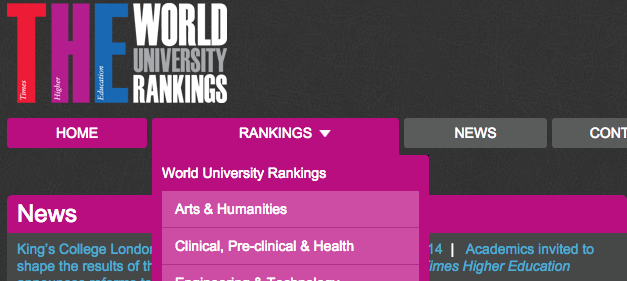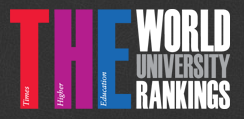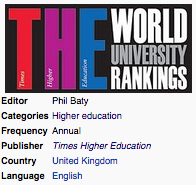타임스 고등교육 세계 대학 평가
위키백과, 우리 모두의 백과사전.
타임즈 고등교육 세계 대학 랭킹 (Times Higher Education World University Rankings)은 전세계 상위권 대학들의 순위를 매긴 것으로 영국 타임즈 고등교육(Times Higher Education, THE)에 의해 출판된다. 2004년부터 전세계 교육 순위를 매긴 출판물로, THE는 원래의 파트너인 QS (Quacquarelli Symonds)에서 2010년 분리되어 나왔으며, 인용 자료 정보를 톰슨 로이터스에게서 받아서 새로운 랭킹 정보 방법론을 만들었다.
평가 방법
2010년 6월 3일, THE는 새로운 세계 대학 랭킹에 축적할 때 이용하도록 제안된 방법론을 밝혔다.
| 주요 항목 | 세부 항목 | 백분율 가중 |
|---|
| 산업 소득 - 혁신 | | |
| 국제화 다양성 | - 내국인 직원에 대한 외국인 직원의 비율
- 내국인 학생에 대한 외국인 학생의 비율
| |
| 교수 – 학습환경 | - 평판 설문 (교수)
- 학교당 PhDs 수상
- 학교당 재학생 인정
- 학교당 소득
- PhDs/재학생 학위 수상
| |
| 연구 – 양, 소득과 평판 | - 평판 설문 (연구)
- 연구 소득 (측정)
- 연구, 교수당 논문수
- 공공 연구 소득/ 전체 연구 소득
| |
| 인용 – 연구 결과 | | |
THE 세계 대학 순위
2014년 상위 20 대학교 THE 세계 대학 순위
THE 세계 평판 랭킹
2011년 3월 , 《타임즈 고등교육》(Times Higher Education)은 최초의 “세계평판랭킹”을 내놓았다. 세계평판랭킹은 타임즈 고등교육 대학 순위의 하위 항목으로 타임즈 고등교육이 사상 세계 최대의 글로벌 대학 여론 조사라고 주장하는 항목들에 기반하고 있다. 이것에는 131개국 13,000개 이상의 학교를 대상으로 조사되었다.
인사이드 하이어 에드(Inside Higher Ed)의 스콧 재식은 이 새로운 순위에 대해서 다음과 같이 말하고 있다.
“ ...순위를 매기는 대부분의 결과들은 객관성에 반하는 명성에 주어지는 가중치 때문에 비난을 받는다. 반면 타임즈 고등교육은 다양한 요소와 결합된 총 순위를 매긴다. 이것으로 인해 평판의 영향에 대해 불명확하다고 비난받을 일이 없는 평점을 내고 있다.
2010년 상위 20위 대학 THE 세계 평판 순위
2014년 THE 아시아 대학 순위 - 국내대학
2014-2015년 THE 세계 대학 평가 - 국내대학

Times Higher Education World University Rankings
From Wikipedia, the free encyclopedia
This article is about the rankings published since 2010. For the rankings using a different methodology and previously published jointly with Quacquarelli Symonds, see QS World University Rankings.
Times Higher Education World University Rankings are annual university rankings published by British Times Higher Education (THE) magazine. The publisher had originally collaborated with another UK organization, Quacquarelli Symonds(QS), to announce the THE–QS World University Rankings during 2004-2009 after which QS has published its rankings with the old methodology as QS World University Rankings, while Times has adopted a new one with citation database supplied by Thomson Reuters since 2010. The publication now comprises the world's overall, subject and reputation rankings with two regional league tables, Asia and BRICS & Emerging Economies rankings, that serve as an extension using exactly the same criteria as those in the world's overall table. Today, Times Higher Education World University Rankings is one of the three most influential and widely observed international university rankings, along with the QS World University Rankings and the Academic Ranking of World Universities (ARWU), and is praised for reducing the weighting of the subjective reputation factor in the main rankings; however, it is also criticized for undermining non-English instructing institutions and being commercialized.
History
The creation of the original Times Higher Education-QS World University Rankings was credited in Ben Wildavsky's book, The Great Brain Race: How Global Universities are Reshaping the World, to then-editor of Times Higher Education, John O'Leary. Times Higher Education chose to partner with educational and careers advice company QS to supply the data.
After the 2009 rankings, Times Higher Education took the decision to break from QS and signed an agreement with Thomson Reuters to provide the data for its annual World University Rankings from 2010 onwards. The publication developed a new rankings methodology in consultation with its readers, its editorial board and Thomson Reuters. Thomson Reuters will collect and analyse the data used to produce the rankings on behalf of Times Higher Education. The first ranking was published in September 2010.
Commenting on Times Higher Education's decision to split from QS, former editor Ann Mroz said: "universities deserve a rigorous, robust and transparent set of rankings – a serious tool for the sector, not just an annual curiosity." She went on to explain the reason behind the decision to continue to produce rankings without QS' involvement, saying that: "The responsibility weighs heavy on our shoulders...we feel we have a duty to improve how we compile them."
Phil Baty, editor of the new Times Higher Education World University Rankings, admitted in Inside Higher Ed: "The rankings of the world's top universities that my magazine has been publishing for the past six years, and which have attracted enormous global attention, are not good enough. In fact, the surveys of reputation, which made up 40 percent of scores and which Times Higher Education until recently defended, had serious weaknesses. And it's clear that our research measures favored the sciences over the humanities."
He went on to describe previous attempts at peer review as "embarrassing" in The Australian: "The sample was simply too small, and the weighting too high, to be taken seriously." THE published its first rankings using its new methodology on 16 September 2010, a month earlier than previous years.
The Times Higher Education World University Rankings, along with the QS World University Rankings and the Academic Ranking of World Universities are described to be the three most influential international university rankings. The Globe and Mail in 2010 described the Times Higher Education World University Rankings to be "arguably the most influential."



